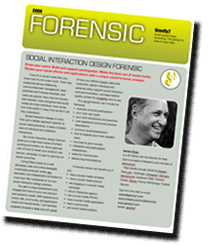I think there are two distinct trends at work here. One, the popularity and adoption of the stream as a form of social conversation. And the other, the conversion of realtime information into value that can be consumed outside the stream. Or to put it another way, the value of being in the flow, and of watching it from the river's edge.
These trends lead to some interesting implications for social media professionals, from designers and developers to brands and businesses. We'll take them separately, and for simplicity's sake distinguish them by interaction "in the flow" and interaction "around the flow." Interaction in the flow is conversation and talk itself — in the form of tweets and updates distributed among friends and across various social spaces. Interaction around the flow involves the value-added actions and activities that use social content, such as rating, diggs, tags, and so on.
In the flow
Many of us are in the stream to communicate. We use the tools available in ways not entirely dissimilar from the ways we have used message boards, IM, chat, and email in the past. We experience it as a kind of online talk. Here, the interaction systems emerging around stream applications focus on ways of improving communication. Twitter's @reply and retweet are examples of these. So, too, is Facebook's recent adoption of activity tagging. Feed readers for streams both reaggregate these distributed conversations and provide for interaction within.
As in all forms of talk, the critical design and experience elements and features include addressing (individual, social, and public audiences intended by the user), subject or object, topic (hashtags, tags), time stamp, and other references (could be @names or could be links). Other distinctions not yet supported would include other linguistic types (request, invitation, answer, greeting, etc), urgency, commercial/individual, and more.
A lot of interesting things happen around conversation and designers are only beginning to wrap their heads around the possibilities for surfacing value, extracting meta data, structuring and organizing talk itself, and so on. Because the primary value of the user experience lies in communication itself, the possibilities are virtually endless.
We can easily imagine a wide range of activities that are currently page or site-based being handled instead by the stream. Invitations, meeting requests, buying and selling, questions/answers — these and much more could be transacted by means of messages "off the page" and extracted or sorted out of streams by smart clients or aggregators. Analytics companies will have a gold mine of relationship data to scrape and visualize, for example, for use by those who want to see how influencers reach their audiences, around what topics, how quickly, with what redistribution, and so on.
The conversation space holds many more opportunities than we can currently take advantage of, in part because many applications are still trying to simplify the experience of being in the flow. At present this requires aggregation of messages posted across numerous contexts. Over time, however, it seems inevitable that conversational tools will be able to offer not only the direct messaging experience but also a variety of benefits from use of metadata, analysis, search, and structure/organization.
Around the flow
For those who spend less of their social media time in the flow, there are the interactions with content instead of person. Many of the long tail services create value through interactions with content that are designed to surface and rank by popularity, trend, similarity, rating, and so on. This is the world of taste-making, and it uses indirect social interaction (meaning not person to person communication) to qualify social content items. Recommendations services depend on the contributions of users to qualify and differentiate content: the more ways there are of differentiating content items, the more ways there are of relating it and providing navigation through it.
The primary goals of interaction models used around the flow involve separating content from the conversational stream, extracting meta data where possible, assigning categories and embedding within content structures and navigational systems. Then the social challenge becomes making it accessible (search, browse, and categorization) and making it socially interesting (lists, rankings, votes, etc).
The disadvantage this older page-based method of social experience has with respect to the recent conversational trend is of course that it's at a remove from the user. The factors that compel us to talk are not available here. Attention is not paid to people directly, but indirectly through means of content. The advantage, however, is of course in the many ways already developed for organizing content and making it available for re-use within other contexts.
[Note: All interactions with social content first involve a selection of something. These indirect kinds of social interaction assign value to the content item (a vote up or down, a rating, a favorite, a tag, etc). Selections in the stream, by contrast, create value by distributing (sharing, replying) communication. There is a critical distinction between the direct communication interaction model and the indirect social action model. Communication uses language; social action uses symbolic tokens and signifying systems like emoticons, icons, ratings, votes, etc.]
...
In each of these two trends, value is in the relationships, either between people or among content elements. Communication itself creates value, but of a kind known best by those involved and extracted only with difficulty. Social content can more easily represent value assigned to items, but must then find ways to restore what made it interesting in the first place.
One could see a new breed of social networking experiences built around messaging, if conversational features can be codified and structured for ease of participation and consumption. It will be interesting to see whether or not this happens. In either case, the emergence of interaction models appropriate for communication and social participation, to streamline communication and to make social content a more interesting experience, holds a lot of promise.
Labels: interaction design, social interaction design, sxd, twitter




Comments: :
blog comments powered by Disqus
<< Home